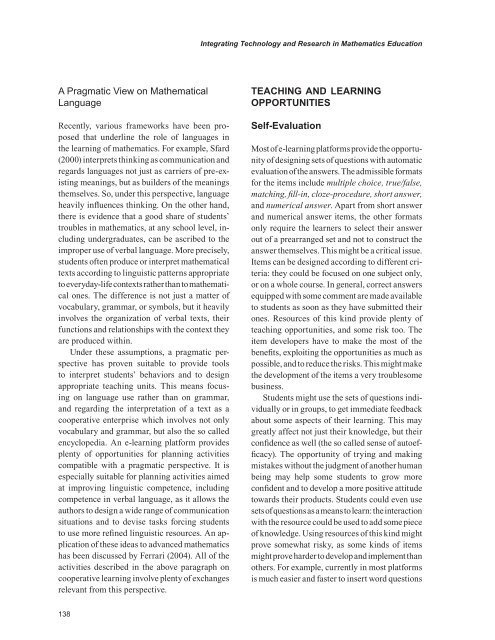Advances in E-learning-Experiences and Methodologies
Create successful ePaper yourself
Turn your PDF publications into a flip-book with our unique Google optimized e-Paper software.
Integrat<strong>in</strong>g Technology <strong>and</strong> Research <strong>in</strong> Mathematics Education<br />
A Pragmatic View on Mathematical<br />
Language<br />
Recently, various frameworks have been proposed<br />
that underl<strong>in</strong>e the role of languages <strong>in</strong><br />
the learn<strong>in</strong>g of mathematics. For example, Sfard<br />
(2000) <strong>in</strong>terprets th<strong>in</strong>k<strong>in</strong>g as communication <strong>and</strong><br />
regards languages not just as carriers of pre-exist<strong>in</strong>g<br />
mean<strong>in</strong>gs, but as builders of the mean<strong>in</strong>gs<br />
themselves. So, under this perspective, language<br />
heavily <strong>in</strong>fluences th<strong>in</strong>k<strong>in</strong>g. On the other h<strong>and</strong>,<br />
there is evidence that a good share of students’<br />
troubles <strong>in</strong> mathematics, at any school level, <strong>in</strong>clud<strong>in</strong>g<br />
undergraduates, can be ascribed to the<br />
improper use of verbal language. More precisely,<br />
students often produce or <strong>in</strong>terpret mathematical<br />
texts accord<strong>in</strong>g to l<strong>in</strong>guistic patterns appropriate<br />
to everyday-life contexts rather than to mathematical<br />
ones. The difference is not just a matter of<br />
vocabulary, grammar, or symbols, but it heavily<br />
<strong>in</strong>volves the organization of verbal texts, their<br />
functions <strong>and</strong> relationships with the context they<br />
are produced with<strong>in</strong>.<br />
Under these assumptions, a pragmatic perspective<br />
has proven suitable to provide tools<br />
to <strong>in</strong>terpret students’ behaviors <strong>and</strong> to design<br />
appropriate teach<strong>in</strong>g units. This means focus<strong>in</strong>g<br />
on language use rather than on grammar,<br />
<strong>and</strong> regard<strong>in</strong>g the <strong>in</strong>terpretation of a text as a<br />
cooperative enterprise which <strong>in</strong>volves not only<br />
vocabulary <strong>and</strong> grammar, but also the so called<br />
encyclopedia. An e-learn<strong>in</strong>g platform provides<br />
plenty of opportunities for plann<strong>in</strong>g activities<br />
compatible with a pragmatic perspective. It is<br />
especially suitable for plann<strong>in</strong>g activities aimed<br />
at improv<strong>in</strong>g l<strong>in</strong>guistic competence, <strong>in</strong>clud<strong>in</strong>g<br />
competence <strong>in</strong> verbal language, as it allows the<br />
authors to design a wide range of communication<br />
situations <strong>and</strong> to devise tasks forc<strong>in</strong>g students<br />
to use more ref<strong>in</strong>ed l<strong>in</strong>guistic resources. An application<br />
of these ideas to advanced mathematics<br />
has been discussed by Ferrari (2004). All of the<br />
activities described <strong>in</strong> the above paragraph on<br />
cooperative learn<strong>in</strong>g <strong>in</strong>volve plenty of exchanges<br />
relevant from this perspective.<br />
teAchIng And LeArnIng<br />
oPPortunItIes<br />
Self-Evaluation<br />
Most of e-learn<strong>in</strong>g platforms provide the opportunity<br />
of design<strong>in</strong>g sets of questions with automatic<br />
evaluation of the answers. The admissible formats<br />
for the items <strong>in</strong>clude multiple choice, true/false,<br />
match<strong>in</strong>g, fill-<strong>in</strong>, cloze-procedure, short answer,<br />
<strong>and</strong> numerical answer. Apart from short answer<br />
<strong>and</strong> numerical answer items, the other formats<br />
only require the learners to select their answer<br />
out of a prearranged set <strong>and</strong> not to construct the<br />
answer themselves. This might be a critical issue.<br />
Items can be designed accord<strong>in</strong>g to different criteria:<br />
they could be focused on one subject only,<br />
or on a whole course. In general, correct answers<br />
equipped with some comment are made available<br />
to students as soon as they have submitted their<br />
ones. Resources of this k<strong>in</strong>d provide plenty of<br />
teach<strong>in</strong>g opportunities, <strong>and</strong> some risk too. The<br />
item developers have to make the most of the<br />
benefits, exploit<strong>in</strong>g the opportunities as much as<br />
possible, <strong>and</strong> to reduce the risks. This might make<br />
the development of the items a very troublesome<br />
bus<strong>in</strong>ess.<br />
Students might use the sets of questions <strong>in</strong>dividually<br />
or <strong>in</strong> groups, to get immediate feedback<br />
about some aspects of their learn<strong>in</strong>g. This may<br />
greatly affect not just their knowledge, but their<br />
confidence as well (the so called sense of autoefficacy).<br />
The opportunity of try<strong>in</strong>g <strong>and</strong> mak<strong>in</strong>g<br />
mistakes without the judgment of another human<br />
be<strong>in</strong>g may help some students to grow more<br />
confident <strong>and</strong> to develop a more positive attitude<br />
towards their products. Students could even use<br />
sets of questions as a means to learn: the <strong>in</strong>teraction<br />
with the resource could be used to add some piece<br />
of knowledge. Us<strong>in</strong>g resources of this k<strong>in</strong>d might<br />
prove somewhat risky, as some k<strong>in</strong>ds of items<br />
might prove harder to develop <strong>and</strong> implement than<br />
others. For example, currently <strong>in</strong> most platforms<br />
is much easier <strong>and</strong> faster to <strong>in</strong>sert word questions


